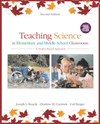 |  Teaching Children Science: A Project-Based Approach, 2/e Joe Krajcik,
University of Michigan - Ann Arbor
Charlene Czerniak,
University of Toledo
Carl Berger,
University of Michigan - Ann Arbor
How Do I Develop Collaboration in the Science Classroom?
Chapter Summary- Collaborative learning is a key feature of project-based science.
- There are three types of collaborative arrangements:
- Among students.
- Between students and teacher.
- Between students and the community.
- Teachers are responsible for creating a collaborative environment.
- Collaboration must be planned. Planning includes
- Forming groups.
- Developing collaborative skills among students in the class.
- Involving all students equitably.
- Students' Collaborative skills need to be developed. These include
- Decision-making.
- Task completion.
- Trust building.
- Communication.
- Conflict management.
- Teachers face many challenges when implementing collaborative groups. These include
- A lack of collaborative skills.
- Loafing.
- The fear of being duped and the dominating of others.
- Status differential.
- Pacts.
- Diversity.
- Socially induced incompetence.
- A belief in the "right answer"
- Lack of support from parents, colleagues, or administrators.
- Collaboration almost always works better than individual learning. There are numerous reasons:
- Multiple zones of proximal development are created among students that help scaffold learning.
- It positively affects achievement, problem solving, and understanding.
- The cognitive load is spread among students.
- It promotes autonomous, motivated learning.
- Anxiety about learning is reduced.
- Groups traditionally left behind in science are more likely to be included.
- Real life skills are developed.
|
|



 2003 McGraw-Hill Higher Education
2003 McGraw-Hill Higher Education